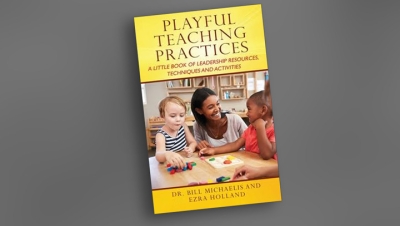Little ones learn through everyday experience
Cultural contracts comparing France and the USA abound, especially regarding childcare. After World War I, the French established nationwide well-funded “creches” for children birth - three years, which today are licensed and regulated by local authorities across the country with great consistency. But more than 75 years earlier—imagine this—in 1844, the first center was built in the first arrondissement (zone) of Paris, and the system grew from that point.
The U.S. currently has no federal childcare policy, although times have come and gone when federal action to support families in caring for children has existed, for example, during World War II. Today differences between states and regions are dramatic.
Further, contrasts between private and publicly-funded care increase the “patchwork picture” of U.S. childcare.
First-time parents describe their confusion when tackling the task of finding adequate center care, like Dr. Dimidjian’s next-door-neighbors in Southwest Florida, Betsy, and Leigh Shein, who note after searching online and in person for care for their toddler Miranda, “Since no comprehensive list existed we had to first compile one from many sources and found no standards for curriculum. Reviewing Inspection Reports was appalling as centers often failed the basic standards, and visits and other parents often give little more real insight.
“Sadly, it becomes a trial-and-error process with your child.” Their words were confirmed that same week in a front-page investigation “Day Care or Nightmare: Analysis of Area Services Finds the Good and the Bad” (The News-Press, 8/26, 2007) made by retired educators and journalists in Southwest Florida, exposing both the excellent and abusive extremes in care, warning parents and community to be vigilant when enrolling a child in private, church-related, or publicly-funded care.
Private childcare has been a growing phenomenon in the U.S. for four decades now but is a very recent innovation in France, and this article illustrates the growth of one of the first private programs in Paris.
However, despite these differences in the history of childcare between France and the U.S., one central tenet links the two countries:
the developmental principle that young children learn best through play, and play must be present during every moment of the daycare day for children to develop optimally.
This short article presents one example of this shared belief as it is put into practice each day in Paris at the daycare center Petit-a-Petit Madame close to the Luxembourg Gardens. The authors are connected through this center, The first meeting was when Dr. Dimidjian helped her granddaughter enroll in the newly opened program where Marcia Alves served as one of three teachers. Marcia made her first trip to the USA when she presented this information at the ACEI conference in Tampa, Fla, with Dr. Dimidjian.
Playing during each step of the day in Paris At Petit-a-Petit Madame, play is at the heart of children’s daily experience. The center is open from 8 a.m. until 7:30 p.m. Monday-Friday, and each child attends on an individualized schedule based on family needs and developmental readiness for group care. Teachers assist little ones who range in age from 12-36 months to step into play activities since teachers understand that playing and learning fuse together to enhance all dimensions of child development. Children attend anywhere from 15 to 40 hours per week with no more than 22 little ones present at any time.
The large, open-room environment with two adjoining rooms is organized in a developmentally appropriate way to support children’s learning, offering security, a sense of warmth, and affirmation. Major areas present opportunities for creative arts, sociodramatic play, vigorous physical activity, building and construction, manipulative play, and toileting/physical care/rest all available throughout the day.
Teaching staff at Petit-a-Petit Madame share the belief that very young children must have opportunities to speak, jump, climb, cuddle, create, and socialize throughout the day. The director Géraldine Lefèbvre joins her team of professionally-trained staff in the classroom for varied hours each week, working with the three teachers and two assistant teachers. Staff work as a team in planning coordinated activities and providing physical and emotional care on a varied schedule working no more than 35 hours/week. All have 5 weeks of paid vacation yearly.
All staff work closely with the 74 families whose little ones have attended the center and consider it essential to involve families in meaningful ways by valuing their questions, encouraging them to support children’s learning, and making them feel welcome at all times.
Staff are bi- or trilingual, which is important since families come from around the globe. Staff speak a total of five languages fluently. They conduct parent meetings in the family’s language, and family events are always done bilingually.
Petit-a-Petit Madame opened in 2005 as a separate private center under the name “Baby’s Cool.” During 2007 it merged with the Petit-a-Petit programs, now offering care in 10 centers across the city. These privately-organized programs have sprung up in response to increasing need centers for children under three years of age. As reported in 7/17 London Times which did a full-page spread on the growth of care in Paris, “Politicians are rushing to open new public crèches and encourage companies and state-sector employers to provide daycare for their staff. Bertrand Delanoe, the past Socialist Mayor of Paris, has opened 4,500 public crèches places since 2001. On taking over city hall, he converted much of the palatial mayoral apartments—inhabited for 18 years by Jacques Chirac and his family—into nurseries for council staff.”
“The crèche can be a satisfying environment for an infant to blossom in on the condition that individualized care is provided.” –Daniele Delouvin
Further, the article stated that currently, one-third of French toddlers spend at least part of the day in state-regulated crèches, public and private. The president of the National Association of Early Childhood Psychologists, Daniele Delouvin, was quoted: “The crèche can be a satisfying environment for an infant to blossom in on the condition that individualized care is provided.”
“Individualization” and “empowerment” are key words in the moment-to-moment organization of the crèche featured here. Children participate in making snacks and meals, determining which of the creative arts are opened up at different points of the day, in choosing different stories to read or games to play. In fact, a recent comment by one little toddler in morning circle time illustrated this well when he loudly proclaimed “I want to decide!” in response to the teacher’s query about what he wanted to do next, then chose the three things he wanted to take on during the morning playtime. He knew deep inside that the environment was his to take and make into constructive activity.
Nearly two decades ago Dr. Dimidjian organized contributions by 20 early childhood experts into an NEA publication emphasizing the importance of play in curriculum for young children, saying, “For the young children whose acquisition of understanding is still so rooted in the body and the web of emotional bonds one has with others, knowledge is best gained through a process of moving, speaking, doing with others, discovering for oneself and mastering new challenges in an environment where play and work are one domain.” (p.13) Staff working as a team give reality to those words today in the step-by-step pieces of the day on rue Madame as shown in the photos above, one from the large room and one in the nearby Luxembourg Garden where children have outdoor playtime every day too.
It is play in all its facets that offers the most visible assurance that each toddler has the space, materials, and adult support to thrive, and the minutes on the floor with the little ones and adults creating together at Petita-Petit Madame show just how productive and meaningful care for little ones can be. As increasing numbers of parents return to employment early in their children’s lives, it is crucial that programs providing lots of caring corners to play, create, and learn increase in both France and the USA.
By Marcia Alves, Ed. Infancia, and Victoria Jean Dimidjian, Ph.D.






















